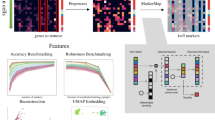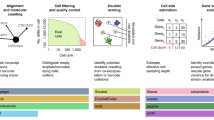Abstract
Single-cell gene expression studies promise to reveal rare cell types and cryptic states, but the high variability of single-cell RNA-seq measurements frustrates efforts to assay transcriptional differences between cells. We introduce the Census algorithm to convert relative RNA-seq expression levels into relative transcript counts without the need for experimental spike-in controls. Analyzing changes in relative transcript counts led to dramatic improvements in accuracy compared to normalized read counts and enabled new statistical tests for identifying developmentally regulated genes. Census counts can be analyzed with widely used regression techniques to reveal changes in cell-fate-dependent gene expression, splicing patterns and allelic imbalances. We reanalyzed single-cell data from several developmental and disease studies, and demonstrate that Census enabled robust analysis at multiple layers of gene regulation. Census is freely available through our updated single-cell analysis toolkit, Monocle 2.
This is a preview of subscription content, access via your institution
Access options
Access Nature and 54 other Nature Portfolio journals
Get Nature+, our best-value online-access subscription
$29.99 / 30 days
cancel any time
Subscribe to this journal
Receive 12 print issues and online access
$259.00 per year
only $21.58 per issue
Buy this article
- Purchase on Springer Link
- Instant access to full article PDF
Prices may be subject to local taxes which are calculated during checkout






Similar content being viewed by others
Accession codes
Primary accessions
ArrayExpress
Gene Expression Omnibus
References
Macosko, E.Z., Basu, A., Satija, R., Nemesh, J. & Shekhar, K. Highly parallel genome-wide expression profiling of individual cells using nanoliter droplets. Cell 161, 1202–1214 (2015).
Klein, A.M. et al. Droplet barcoding for single-cell transcriptomics applied to embryonic stem cells. Cell 161, 1187–1201 (2015).
Shalek, A.K. et al. Single-cell transcriptomics reveals bimodality in expression and splicing in immune cells. Nature 498, 236–240 (2013).
Grün, D., Kester, L. & van Oudenaarden, A. Validation of noise models for single-cell transcriptomics. Nat. Methods 11, 637–640 (2014).
Finak, G. et al. MAST: a flexible statistical framework for assessing transcriptional changes and characterizing heterogeneity in single-cell RNA sequencing data. Genome Biol. 16, 278 (2015).
Jiang, L. et al. Synthetic spike-in standards for RNA-seq experiments. Genome Res. 21, 1543–1551 (2011).
Fu, G.K., Hu, J., Wang, P.-H. & Fodor, S.P.A. Counting individual DNA molecules by the stochastic attachment of diverse labels. Proc. Natl. Acad. Sci. USA 108, 9026–9031 (2011).
Hug, H. & Schuler, R. Measurement of the number of molecules of a single mRNA species in a complex mRNA preparation. J. Theor. Biol. 221, 615–624 (2003).
Picelli, S., Faridani, O.R., Björklund, A.K. & Winberg, G. Full-length RNA-seq from single cells using Smart-seq2. Nat. Protoc. 9, 171–181 (2014).
Petropoulos, S. et al. Single-cell RNA-seq reveals lineage and X chromosome dynamics in human preimplantation embryos. Cell 165, 1012–1026 (2016).
Segerstolpe, Å. et al. Single-cell transcriptome profiling of human pancreatic islets in health and type 2 diabetes. Cell Metab. 24, 593–607 (2016).
Zeisel, A. et al. Cell types in the mouse cortex and hippocampus revealed by single-cell RNA-seq. Science 347, 1138–1142 (2015).
Jaitin, D.A. et al. Massively parallel single-cell RNA-seq for marker-free decomposition of tissues into cell types. Science 343, 776–779 (2014).
Wu, A.R. et al. Quantitative assessment of single-cell RNA-sequencing methods. Nat. Methods 11, 41–46 (2014).
Treutlein, B. et al. Dissecting direct reprogramming from fibroblast to neuron using single-cell RNA-seq. Nature 534, 391–395 (2016).
Robinson, M.D., McCarthy, D.J. & Smyth, G.K. edgeR: a Bioconductor package for differential expression analysis of digital gene expression data. Bioinformatics 26, 139–140 (2010).
Love, M.I., Huber, W. & Anders, S. Moderated estimation of fold change and dispersion for RNA-seq data with DESeq2. Genome Biol. 15, 550 (2014).
Trapnell, C. et al. The dynamics and regulators of cell fate decisions are revealed by pseudotemporal ordering of single cells. Nat. Biotechnol. 32, 381–386 (2014).
Kharchenko, P.V., Silberstein, L. & Scadden, D.T. Bayesian approach to single-cell differential expression analysis. Nat. Methods 11, 740–742 (2014).
Tang, F. et al. Tracing the derivation of embryonic stem cells from the inner cell mass by single-cell RNA-Seq analysis. Cell Stem Cell 6, 468–478 (2010).
Buganim, Y. et al. Single-cell expression analyses during cellular reprogramming reveal an early stochastic and a late hierarchic phase. Cell 150, 1209–1222 (2012).
Zhou, J.X. & Huang, S. Understanding gene circuits at cell-fate branch points for rational cell reprogramming. Trends Genet. 27, 55–62 (2011).
Moignard, V. et al. Decoding the regulatory network of early blood development from single-cell gene expression measurements. Nat. Biotechnol. 33, 269–276 (2015).
Marco, E. et al. Bifurcation analysis of single-cell gene expression data reveals epigenetic landscape. Proc. Natl. Acad. Sci. USA 111, E5643–E5650 (2014).
Treutlein, B. et al. Reconstructing lineage hierarchies of the distal lung epithelium using single-cell RNA-seq. Nature 509, 371–375 (2014).
Hochegger, H., Takeda, S. & Hunt, T. Cyclin-dependent kinases and cell-cycle transitions: does one fit all? Nat. Rev. Mol. Cell Biol. 9, 910–916 (2008).
Desai, T.J., Brownfield, D.G. & Krasnow, M.A. Alveolar progenitor and stem cells in lung development, renewal and cancer. Nature 507, 190–194 (2014).
Chi, X., Garnier, G., Hawgood, S. & Colten, H.R. Identification of a novel alternatively spliced mRNA of murine pulmonary surfactant protein B. Am. J. Respir. Cell Mol. Biol. 19, 107–113 (1998).
McCullagh, P. & Nelder, J.A. Generalized Linear Models 2nd edn. (CRC Press, 1989).
Shu, W. et al. Foxp2 and Foxp1 cooperatively regulate lung and esophagus development. Development 134, 1991–2000 (2007).
Yin, Y. et al. An FGF-WNT gene regulatory network controls lung mesenchyme development. Dev. Biol. 319, 426–436 (2008).
Shu, W., Yang, H., Zhang, L., Lu, M.M. & Morrisey, E.E. Characterization of a new subfamily of winged-helix/forkhead (Fox) genes that are expressed in the lung and act as transcriptional repressors. J. Biol. Chem. 276, 27488–27497 (2001).
Wan, H. et al. Kruppel-like factor 5 is required for perinatal lung morphogenesis and function. Development 135, 2563–2572 (2008).
Xu, Y. et al. C/EBPα is required for pulmonary cytoprotection during hyperoxia. Am. J. Physiol. Lung Cell. Mol. Physiol. 297, L286–L298 (2009).
Okubo, T. & Hogan, B.L.M. Hyperactive Wnt signaling changes the developmental potential of embryonic lung endoderm. J. Biol. 3, 11 (2004).
Shalek, A.K. et al. Single-cell RNA-seq reveals dynamic paracrine control of cellular variation. Nature 510, 363–369 (2014).
Darnell, J.E. Jr., Kerr, I.M. & Stark, G.R. Jak-STAT pathways and transcriptional activation in response to IFNs and other extracellular signaling proteins. Science 264, 1415–1421 (1994).
Honda, K. et al. IRF-7 is the master regulator of type-I interferon–dependent immune responses. Nature 434, 772–777 (2005).
Gautier, G. et al. A type I interferon autocrine-paracrine loop is involved in Toll-like receptor–induced interleukin-12p70 secretion by dendritic cells. J. Exp. Med. 201, 1435–1446 (2005).
Lavin, Y. et al. Tissue-resident macrophage enhancer landscapes are shaped by the local microenvironment. Cell 159, 1312–1326 (2014).
Welch, J.D., Hu, Y. & Prins, J.F. Robust detection of alternative splicing in a population of single cells. Nucleic Acids Res. 44, e73 (2016).
Perrin, B.J. & Ervasti, J.M. The actin gene family: function follows isoform. Cytoskeleton 67, 630–634 (2010).
Tondeleir, D., Vandamme, D., Vandekerckhove, J., Ampe, C. & Lambrechts, A. Actin isoform expression patterns during mammalian development and in pathology: insights from mouse models. Cell Motil. Cytoskeleton 66, 798–815 (2009).
Gunning, P., O'Neill, G. & Hardeman, E. Tropomyosin-based regulation of the actin cytoskeleton in time and space. Physiol. Rev. 88, 1–35 (2008).
Deng, Q., Ramsköld, D., Reinius, B. & Sandberg, R. Single-cell RNA-seq reveals dynamic, random monoallelic gene expression in mammalian cells. Science 343, 193–196 (2014).
Bray, N.L., Pimentel, H., Melsted, P. & Pachter, L. Near-optimal probabilistic RNA-seq quantification. Nat. Biotechnol. 34, 525–527 (2016).
Kim, J.K., Kolodziejczyk, A.A., Ilicic, T., Teichmann, S.A. & Marioni, J.C. Characterizing noise structure in single-cell RNA-seq distinguishes genuine from technical stochastic allelic expression. Nat. Commun. 6, 8687 (2015).
Amit, I. et al. Unbiased reconstruction of a mammalian transcriptional network mediating pathogen responses. Science 326, 257–263 (2009).
Anders, S. & Huber, W. Differential expression analysis for sequence count data. Genome Biol. 11, R106 (2010).
Yee, T.W. Vector Generalized Linear and Additive Models (Springer, 2015).
Katz, Y., Wang, E.T., Airoldi, E.M. & Burge, C.B. Analysis and design of RNA sequencing experiments for identifying isoform regulation. Nat. Methods 7, 1009–1015 (2010).
Keane, T.M. et al. Mouse genomic variation and its effect on phenotypes and gene regulation. Nature 477, 289–294 (2011).
Corbel, C., Diabangouaya, P., Gendrel, A.-V., Chow, J.C. & Heard, E. Unusual chromatin status and organization of the inactive X chromosome in murine trophoblast giant cells. Development 140, 861–872 (2013).
Yang, F., Babak, T., Shendure, J. & Disteche, C.M. Global survey of escape from X inactivation by RNA-sequencing in mouse. Genome Res. 20, 614–622 (2010).
Acknowledgements
We thank J. Shi and S. Xu for technical discussions, M. Kircher for cluster computation support, and J. Shendure, R. Hause, D. Cusanovich, B. Trapnell, J. Whitsett and members of the Trapnell laboratory for comments on the manuscript. This work was supported by US National Institutes of Health (NIH) grant DP2 HD088158. C.T. is partly supported by a Dale. F. Frey Award for Breakthrough Scientists and an Alfred P. Sloan Foundation Research Fellowship. A.H. is supported by a National Science Foundation (NSF) Graduate Research Fellowship.
Author information
Authors and Affiliations
Contributions
X.Q. and C.T. designed Census and the regression methods. X.Q. implemented the methods. X.Q. and A.H. performed the analysis. J.P., D.L. and Y.-A.M. contributed to technical design. C.T. conceived the project. All authors wrote the manuscript.
Corresponding author
Ethics declarations
Competing interests
The authors declare no competing financial interests.
Supplementary information
Supplementary Text and Figures
Supplementary Figures 1–15, Supplementary Table 2 and Supplementary Note 1 (PDF 17987 kb)
Supplementary Tables
Supplementary Table 1 (XLSX 166 kb)
Supplementary Data
Text file storing the result (p-value) from the permutation test used in benchmarking differential gene expression based on spike-in transcript counts. Each row corresponds to a gene. (TXT 1113 kb)
Supplementary Software
A tarball includes a version of monocle 2 (version: 1.99) used to produce all the figures, supplementary data is provided along with this submission and a helper package including helper functions are included as well as all analysis code which can reproduce all figures in this study are provided. (ZIP 6397 kb)
Rights and permissions
About this article
Cite this article
Qiu, X., Hill, A., Packer, J. et al. Single-cell mRNA quantification and differential analysis with Census. Nat Methods 14, 309–315 (2017). https://doi.org/10.1038/nmeth.4150
Received:
Accepted:
Published:
Issue Date:
DOI: https://doi.org/10.1038/nmeth.4150
This article is cited by
-
Integrative single-cell transcriptomic analyses reveal the cellular ontological and functional heterogeneities of primary and metastatic liver tumors
Journal of Translational Medicine (2024)
-
Single-cell profiling of response to neoadjuvant chemo-immunotherapy in surgically resectable esophageal squamous cell carcinoma
Genome Medicine (2024)
-
A cell atlas of the larval Aedes aegypti ventral nerve cord
Neural Development (2024)
-
Architecting the metabolic reprogramming survival risk framework in LUAD through single-cell landscape analysis: three-stage ensemble learning with genetic algorithm optimization
Journal of Translational Medicine (2024)
-
Sprouty genes regulate activated fibroblasts in mammary epithelial development and breast cancer
Cell Death & Disease (2024)



